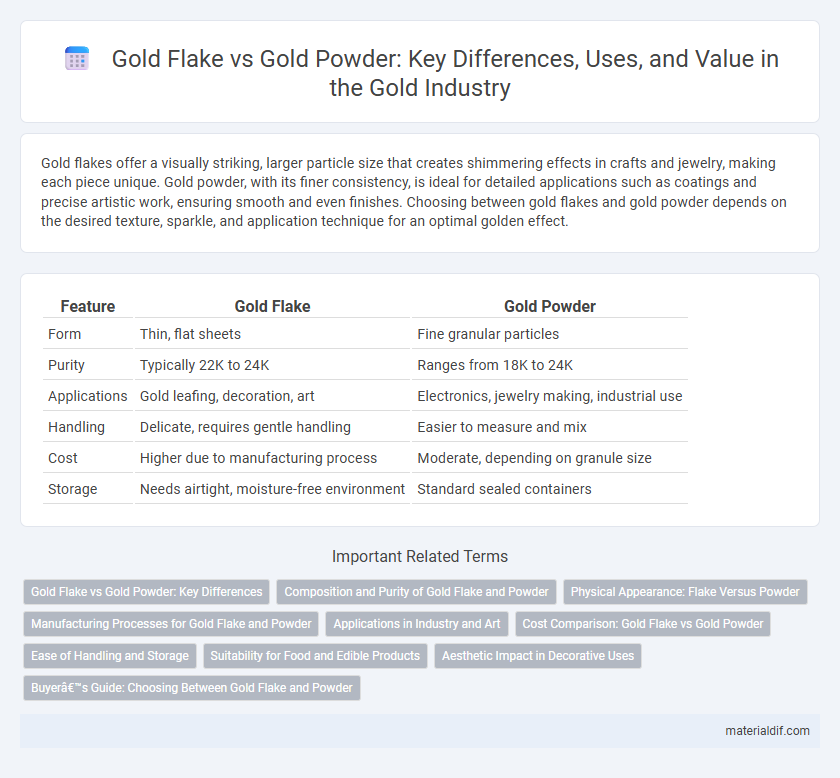Gold flakes offer a visually striking, larger particle size that creates shimmering effects in crafts and jewelry, making each piece unique. Gold powder, with its finer consistency, is ideal for detailed applications such as coatings and precise artistic work, ensuring smooth and even finishes. Choosing between gold flakes and gold powder depends on the desired texture, sparkle, and application technique for an optimal golden effect.
Table of Comparison
| Feature | Gold Flake | Gold Powder |
|---|---|---|
| Form | Thin, flat sheets | Fine granular particles |
| Purity | Typically 22K to 24K | Ranges from 18K to 24K |
| Applications | Gold leafing, decoration, art | Electronics, jewelry making, industrial use |
| Handling | Delicate, requires gentle handling | Easier to measure and mix |
| Cost | Higher due to manufacturing process | Moderate, depending on granule size |
| Storage | Needs airtight, moisture-free environment | Standard sealed containers |
Gold Flake vs Gold Powder: Key Differences
Gold flakes are thin, flat pieces of gold typically used for decorative purposes, while gold powder consists of finely ground particles often utilized in industrial applications and jewelry making. Flakes offer a visually striking appearance with easy application in artistic projects, whereas powder provides versatility for alloy creation and chemical processes. The key differences lie in texture, usage, and particle size, influencing their suitability for specific commercial and craft uses.
Composition and Purity of Gold Flake and Powder
Gold flake typically consists of thin, delicate sheets of almost pure gold, often achieving purities of 99.9% or higher, making it ideal for culinary and decorative uses where purity is crucial. Gold powder, by contrast, can vary significantly in composition, sometimes containing impurities or binders, which affects its overall purity and suitability for industrial or artistic applications. The refinement process for flakes generally yields higher purity compared to powder, due to the controlled manufacturing methods designed to maintain gold's elemental integrity.
Physical Appearance: Flake Versus Powder
Gold flakes exhibit a thin, plate-like structure with a shiny, lustrous surface that reflects light unevenly, creating a textured visual effect. In contrast, gold powder consists of fine, granular particles that appear matte or slightly shimmering due to their small size and more uniform light reflection. The difference in physical appearance between gold flake and gold powder affects their use in applications such as jewelry, cosmetics, and industrial processes.
Manufacturing Processes for Gold Flake and Powder
Gold flake production involves laminating ultra-thin sheets of pure gold through sophisticated rolling mills that reduce gold to micro-scale thickness without compromising its malleability. In contrast, gold powder is synthesized via atomization or chemical reduction techniques, where molten gold is dispersed or chemically precipitated into fine particulate form with controlled particle size distribution. Both manufacturing processes require precise temperature control and purity maintenance to ensure consistency in the physical properties tailored for industrial and decorative applications.
Applications in Industry and Art
Gold flake and gold powder serve distinct purposes in industry and art, with gold flake often utilized in decorative applications such as gilding, luxury packaging, and fine art restoration due to its delicate, malleable nature. Gold powder finds extensive use in electronics for conductive inks, dental alloys, and high-precision additive manufacturing because of its uniform particle size and superior conductivity. Both forms enhance aesthetic and functional properties, with gold flake emphasizing visual richness and gold powder enabling technical performance in advanced industrial processes.
Cost Comparison: Gold Flake vs Gold Powder
Gold flakes generally cost less per gram compared to gold powder due to lower processing requirements and less refinement involved in their production. Gold powder, being finely ground and often more purified, commands a higher price reflecting its increased value in industrial applications and jewelry manufacturing. The cost difference between gold flake and gold powder depends significantly on the purity, particle size, and intended use, with gold powder typically positioned as the premium option due to its versatility and higher surface area.
Ease of Handling and Storage
Gold flakes offer easier handling due to their larger, more manageable size compared to fine gold powder, which tends to be messy and prone to airborne dispersion. Storage of gold flakes requires less specialized containment, as their reduced surface area minimizes oxidation risks, unlike gold powder that demands airtight, anti-static containers to prevent contamination and loss. Both forms retain intrinsic value, but flakes provide practical advantages for artisanal applications and safer long-term storage.
Suitability for Food and Edible Products
Gold flake is ideal for decorating food and edible products due to its delicate texture and ease of application, providing an elegant shimmer without altering flavor. Gold powder, while also edible, is finer and better suited for mixing into ingredients or creating detailed designs that require precision. Both forms are sourced from pure, food-grade gold ensuring safety and aesthetic appeal in gourmet culinary uses.
Aesthetic Impact in Decorative Uses
Gold flakes provide a textured, luxurious shimmer that enhances the tactile depth of decorative surfaces, making them ideal for detailed art and crafts. Gold powder offers a smooth, uniform finish that is perfect for creating consistent, radiant coatings in jewelry and fine decorations. Both forms enrich aesthetic appeal but differ in their visual texture and application precision.
Buyer’s Guide: Choosing Between Gold Flake and Powder
Gold flakes offer a decorative appeal with their larger, irregular shapes ideal for culinary, cosmetic, and artistic applications, while gold powder provides a finer consistency preferred for industrial uses such as electronics and precise coatings. Buyers should consider the intended use, as gold flakes enhance visual impact and texture, whereas gold powder allows for smoother, more uniform coverage and better integration in manufacturing processes. Pricing and purity also vary, with flakes often commanding a premium for aesthetics, whereas powder is selected for functional performance and ease of application.
Gold Flake vs Gold Powder Infographic

 materialdif.com
materialdif.com